(Descriptive panel on the Coalmining Display at Eskbank House). In 1838, Andrew Brown of “Cooerwull” wrote in his diary ‘getting coal’. This is the first written record of coal in the Lithgow Valley. His mine was very small and was located in one of his paddocks near the corner of Hassans Walls Road and Wrights Road, Lithgow.
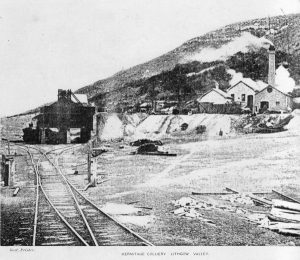
In 1868, the construction of the railway line through the Valley brought workmen who built camps of huts and shanties, slab schools, churches and grog shops, close to the cuttings, embankments and viaducts through the length of the valley. To supply their needs for cooking fires and for heating during the cold winter, a Mr. Poole opened the mine that is now known as the Hermitage Colliery. This was the first commercial mine to engage in mining and selling coal, firstly to the people and later to the construction company for use in the small engines they used.
By 1874, there were four mines producing – Eskbank Colliery (at the eastern end of Main Street near the present Hoskins Church) the Lithgow Valley Colliery, Vale of Clywdd Colliery (whose dedication stone is on display in the grounds of Eskbank House) and the Hermitage Colliery.
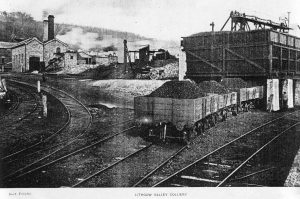
It was generally the practice when companies wanted to start factories and workshops, to build and operate them near the coal supply. It was cheaper to haul the ores to the coal source than to transport the coal, being of greater weight and volume, to another place, and the Lithgow Valley with its vast supply of coal was soon being the western coalfields and attracting the notice of men wishing to engage in manufacture.
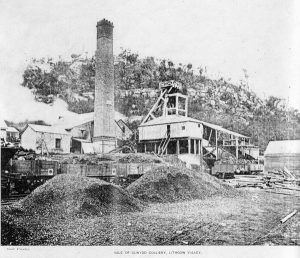
Enoch Hughs, a skilled iron-maker travelling in the district, was impressed by the proximity of iron ores, limestone and coal and he began the Eskbank Ironworks very close to the Eskbank Mine. Lloyd Brothers were interested in deposits of ores containing coppery in the Bathurst and Blayney areas began carting them to Lithgow and set up a smelting works near the Eskbank Mine. Another operator found a clay quarry where the Hoskins Uniting Church now stands and started the Eskbank Brickworks. The owners of the Lithgow Valley Colliery secured contracts to supply coal to the Railways to run their locomotives. The company also began to develop a quarry of clay near to their mine and commenced manufacture of bricks and pipes. Later they produced items of pottery, examples of some of these are displayed in the museum.
The owners of the Vale of Clywdd Colliery opened a quarry and made plans for copper smelting.
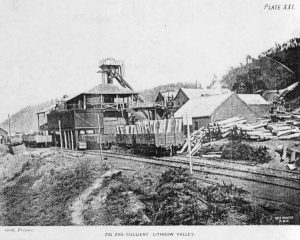
Thomas Sutcliffe Mort mined coal at Zig Zag Colliery to supply his meat and freezing works which he had established at Morts Estate, Lithgow. The meat was forwarded to Sydney in a frozen condition in specially built rail trucks.
Other mines were afterwards opened, among them, the State Mine to supply the government railways and later a power station which was built adjacent to the mine – the Steelworks Colliery to supply the Steelworks..the Iron Works Colliery supplied the Ironworks..and Cobar Colliery supplied the Great Cobar Company which was engaged in recovering copper, silver and gold from ores brought form Cobar, N.S.W. These and others engaged in supplying local and Sydney trade, but the shortage of railway trucks was an acute problem.
The most pathetic disaster was at the Lithgow Valley Colliery in 1886, resulting from an underground fire and explosion, which caused the death of eight men. This mine was ventilated with a steam engine situated underground and men leaving at the end of the shift reported excess smoke. Three men investigating were later found suffocated. Brick stoppings were built to seal off the fire and after five weeks closure, an investigating party entering the mine and taking off the cover were enveloped in a tremendous explosion resulting in the death of a further five men. In 1920, as a result of a small fire in the Oakey Park Colliery between Saturday afternoon and early Sunday, 298 valuable horses used in working the Colliery were suffocated – it should be explained that horses were kept in the pit and only taken to the surface occasionally. There were horses still working in the mines in 1950.
Today, of the 13 mines in the Lithgow Valley, one is still in operation, the Hermitage Colliery. Why? Some have taken out all the coal available in their workings..Methven, Eskbank..others have followed along seams that have become too narrow to work..Cooerwull.. others have dug the coal for such distances underground that the distance from the entrance has entailed too long hauls for the coal and too much travelling time for the miners to get to and from their working places – State Mine and Steelworks..others have become dangerous.
In 1928, Farmers Creek was flooded from a severe thunderstorm. The main tunnel of the Cobar Colliery passed under the creek at the shallow depth and the water cut its way into the workings. For two days, millions of gallons of water poured into the mine, destroying plant and machinery and packing the mine with sand and rubble. The waters found entrance to the workings of adjacent mines including the Zig Zag and Oakey Park Collieries and built up a very dangerous pressure against the wall of the State Mine.
We must remember too, that the mining companies have also found it profitable to open new modern mines, mines which they have planned for the working of the giant machines of today. There are many of these mines operating in areas around the Lithgow Valley. (For more information and historic displays visit Eskbank House)
COAL MINING IN LITHGOW
Lithgow lies in the centre of the Western Coalfield which extends in anorth-westerly direction from Katoomba, through Hartley, Lithgow, Cullen Bullen and Kandos to Ulan near Mudgee, covering approximately 240 kilometres. Most collieries are situated along the Sydney to Mudgee rail line.
There are six coal seams in the area: ‘Katoomba’ which is worked from Hartley; ‘Irondale’ which is worked from Wallerawang; ‘Lidsdale’ worked from Lidsdale and ‘Lithgow’ which is the most significant of all of the seams, and is worked from throughout the whole Western District. The coal won from these seams istypically used in steam production, for activities such as power plant usage.
It is reputed that the first coal in Lithgow was cut by Andrew Brown of Bowenfels with reports confirming that Brown was using coal for a steam engine at his flour mill from the 1850s (Cremin etal 1987, p3).
The coal seams around Lithgow were important for the development of the Great Western Railway, whose viability without this source of abundant coal reserves may have been doubtful.
Coal for trading purposes was first mined in 1868 by Mr. Pooleon the Hermitage Estate owned by the Reverend Colin Stewart.
Production at the Eskbank Colliery followed soon afterwards commencing operations in 1872 and producing 4,321 tons of coal. The Eskbank Colliery was developed by Thomas Brown with the original colliery sited behind the old Union Theatre.
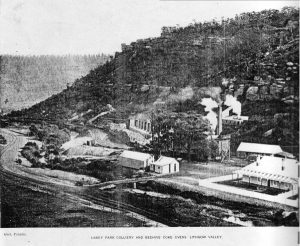
In 1873 the Hermitage and Eskbank Collieries were the only mines selling coal within the district. Two other sites, however were soon to be developed as the Lithgow Valley Colliery, and the Vale of Clwydd Colliery established by the tobacco magnate Thomas Saywell.
Numerous coal mines have operated within the area including the Oakey Park Colliery Co. which operated between 1888 and 1941 and supplied electricity to Lithgow, the Great Cobar which supplied coal to the copper refining furnaces from 1899, the State Coal Mine opened by the New South Wales Railways in 1920, the Bowenfels/Tankersley Mine, the Steelworks Colliery and the Newcom Colliery established in 1951 to supply the Wallerawang Power Station.
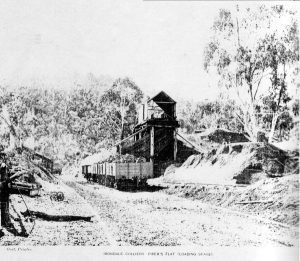
Wallerawang Collieries
Coaling began in Wallerawang around 1873 with a number of mines being opened on the
Lithgow seam at Mount Piper, mid-way between Wallerawang and Lidsdale.
The main mines at Wallerawang included:
The Irondale Colliery; Cullen Bullen Colliery; The Ivanhoe Colliery; The Commonwealth Colliery; The Great Western Mine; and The Invincible Colliery.

Between 1900 and 1910 several small mines were also opened between Piper’s Flat and Blackman’s Flat including:
Black Diamond Mine (later known as Western Mine); Wallace’s Colliery (later known as Huon); Neubeck’s Mine; Springvale Colliery; The Commonwealth Colliery, which was the firstopen cut mine in New South Wales; Newcom Colliery; and The Angus Colliery, opened in 1978 after the Wallerawang Power Station was augmented with an additional two generators.
The City of Lithgow acknowledges and appreciates the above History excerpts taken from the Draft Economic Development Strategy for Lithgow which was researched and compiled by Economic and Community Development Class, University of Sydney October 1996
Photos copied from the “Geology and Mineral resources of the Western Coal-field”, by Mr. J. R. Carne, F.G.S., Assistant Government Geologist. 1907



